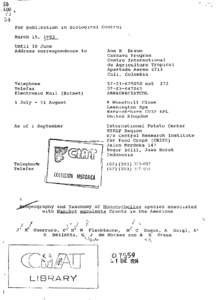Biogeography and taxonomy of Mononychellus species associated with Manihot esculenta Crantz in the Americas
We mapped the distribution of Mononychellus spp. associated with cassava based on survey of 1264 fields in thirteen Central and South American countries. We collectred M. tanajoa (Bondar) in Panama, Colombia, Venezuela, Guyana, Trinidad and Tobago, Brazil and Paraguay, but not north of Panama, nor south of Colombia in the Andean region. M. tanajoa was primarily associated with humid to seasonally dry lowlands except in northeast Brazil, were the ecological range extends to semiarid lowland areas. M. caribbeanae (McGregor) was the most geographically widespread species, and was the predominant species of Mononychellus on cassava in semiarid lowland areas, except in northeast Brazil, Peru or Paraguay where it does not occur. We found M. mcgregori Flechtmann and Baker in humid highlands (interandean valleys) of Colombia, Ecuador and Peru, in subtropical southern Brazil, and in the Colombian region of the Amazon Basin (humid lowlands). M. planki (McGregor) was collected from one field in northeast Brazil and from five fields in Colombia. Mononychellus tanajoa (Bondar) is a polymorphic species with considerable variability in the length of the dorsocentral setae D1, D2 and D3. We found polymorphic populations of M. tanajoa in throughout its known range in the Americas, except in northeast Brazil where setal morphology is skewed towards the short extreme of the phenotypic range. The largest number of Mononychellus species on cassava and a high degree of setal polymorphism in M. tanajoa ocurred in Colombia. Several implications for biological control of M. tanajoa follow from the existence of a geographical subpopulation distinct from other populations in the American of African range of this species

